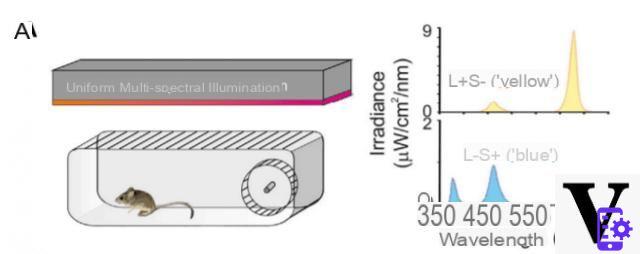The blue light problem
Our body clocks use melanopsin, a light-sensitive protein in our eye, to measure ambient light and decide whether to produce melatonin - also known as the sleep hormone, for example. Melanopsin, however, is more sensitive to shorter wavelength photons, namely blue to green lights.
We deduce that the blue light that we commonly find in our computer or smartphone screens would disrupt our circadian cycle by deceiving our body, making it believe that the light is still powerful, thus preventing our brain from creating enough melatonin to put us to sleep.
This is why we currently find on iOS and Android (but also on Windows and other systems) a "night mode" reducing blue lights and giving a yellow tint to our screens.
New study says otherwise
Dr. Tim Brown's team, however, started from the premise that natural nocturnal light tends more towards bluish colors, while daytime lights tend more towards warm colors, and that it would therefore be more obvious that our cycle is based on these shades. The researchers therefore carried out tests on mice by exposing them to a more "yellow" or more "blue" light, without reducing the brightness itself.
The result contradicts popular beliefs since the circadian cycle of rodents is lengthened under yellow light and reduced under blue light, with, no matter what, an extended cycle if the brightness is increased.

“Our results suggest that the use of dim lights, cooler in the evening and warmer during the day may be more beneficial,” explains Dr. Tim Brown, recalling that this study conducted on mice could possibly be verified in others. mammals, such as primates (and therefore humans), but this has not yet been demonstrated.
The uninteresting night mode?
Should we therefore completely stop using the night mode of our smartphones? Not really. Indeed, doctor Tim Brown specifies that this study concerns equal luminosities and that the current approach leads to lower luminosity by reducing blue lights. You can also see this by switching your smartphone to night mode on a dark image and noting that it becomes more difficult to view.
If we are to believe this study, the night mode would therefore send “mixed” signals to the brain since yellow light would tend to lengthen our circadian cycle where the reduction in luminosity would tend to shorten it. In addition, the tests were carried out with “blue” lights with wavelengths of 385 and 460 nm, with a strong dominant of waves approaching turquoise (490 nm). However, turquoise waves were already announced by some as beneficial for the circadian cycle, unlike blue-violet (even shorter waves).
These blue lights can cause more serious problems
Moreover, beyond the circadian rhythm, blue light filters for our screens have other interests. Indeed, studies tend to show that these blue lights can cause more serious problems such as cataracts or retinal damage that can lead to the creation of blind spots or to the faster aging of the retina.
As you will have understood, the best way to protect yourself is to avoid screens, day or night.
To follow us, we invite you to download our Android and iOS application. You will be able to read our articles, files, and watch our latest YouTube videos.




















![[Review] Samsung Powerbot VR7000: the robot vacuum cleaner from Star Wars](/images/posts/6bc44de38605b5c0fa12661febb1f8af-0.jpg)





